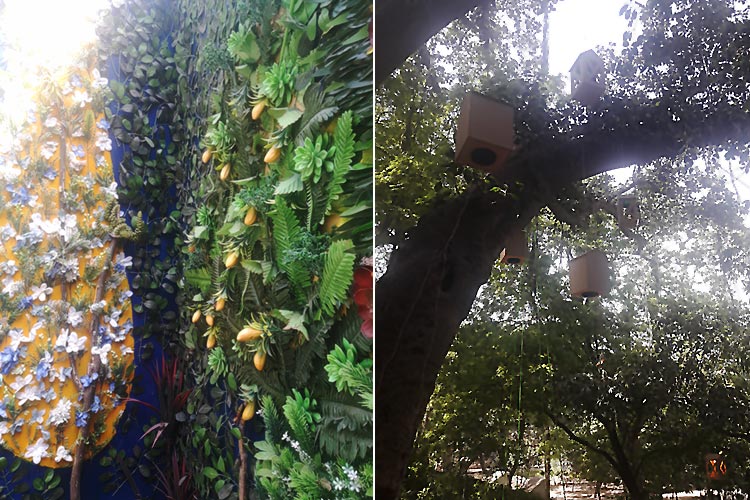Written by: Varda Nisar
Posted on: March 29, 2018 |  | 中文
| 中文
Inauguration ceremony of Lahore Biennale 01 at Lahore Fort (Source: Daily Times)
Pakistan has recently been abuzz with Biennales, having the honour of hosting two within the space of six months, placing itself firmly on the Art World Map – that is if someone thought we weren’t there already! While we witnessed the first edition of the Karachi Biennale in October 2017, the year 2018 saw the debut of Lahore Biennale, which means that for those interested in art, a visual extravaganza will be taking place each year.
Biennales, or events that are held every two years, have become synonymous with Art Festivals, the roots of which can be traced back to the first ever Venice Biennale, held in 1895. There are nearly 230 biennales held around the world, the most famous of them being The Whitney Biennale, Sharjah Biennale and Istanbul Biennial. The relatively simplistic ones provide a frame of reference through material, mediums, or themes, for example Fellbach Triennial of Small-scale Sculpture (Germany) while the more complex ones take upon a theoretical framework to challenge the status quo, such as the Ghetto Biennale (Haiti) and Qalandiya International (Palestine).

In terms of impact, Biennales provide a fresh lens to interpret artwork and also bring the International Art Scene to the host country, thus encouraging interaction with new voices. The economy is boosted, ranging from a direct impact on tourism to a new lease of life for degenerating urban areas. Intangible aspects include the creation of dialogue, a better relationship between art, public spaces and the viewer, and taking art out of the white cube.
Considering the expectations attached with Biennales, the task for Lahore Biennale Foundation (LBF) could not have been easy. As far back as 2015, their many projects came to life, such as “Intersections,” a project undertaken by Atif Khan at Istanbul Chowk. Research residencies and ideas like “Innovations in Public Spaces” set a new bar for public art.
The Lahore Biennale 01 (LB01) launched on the 18th of March under the theme of ‘Shehr-o-Funn.’ It highlights both the cultural significance of Lahore, as well as the modern dimensions the city is negotiating for itself. The seven venues include the Lahore Fort, Shahi Hammam, Mubarak Haveli, Lahore Museum, Alhamra Art Centre, Bagh-e-Jinnah, and the intersection of Canal and Mall Road.
I began my journey on this artistic adventure from Mubarak Haveli. While LBF has also developed an app for navigation, with the details of each work on each site, finding your way in and around the androon shehr can be quite a task, and therefore I put my trust in the capable hands of a rickshaw wala. As you pass through the chaos, you don’t expect to find such an oasis of peace and calm as Mubarak Haveli turns out to be.
Three works that truly stood out were “Priya” by Alia Syed, “Railway Longings” by Rasel Chowdhury and “Incomplete Thombu” by T. Shanaathanan. In Priya, we see a dancer from above – a view rarely seen by the audience – while the quality of the film has been changed through burying the cassette for a year. Through a new perspective and different quality, we are introduced to the dance afresh, while questioning the effect of time! In Shanaathanan’s work, one finds the pain and tragedy of the displaced civilians in Sri Lanka during the Civil War. The work records memories and drawings, with a bold disclaimer that all works in the book are real. The way this artist book is created, points towards the multi-dimensional aspects of displacement and loss.
In the Shahi Hammam, we are met with work by three artists; Imran Qureshi and Aisha Khalid, who take centre stage, and Manisha Gera Baswani. Imran sticks to his iconic blood splattering, displaying it on canvas and thus giving violence a historical perspective in this building. Aisha’s work, on the other hand, is more introspective; a huge octagonal mirror covers the ground and reflects the frescos of the dome, broken only by her orange tape which points to the many global and regional factors involved in her thinking. Another work by her involves floral miniature drawings, fitted into the niches of the Hammam, and inspired by its frescoes. Her iconic orange tape is the only thing that differentiates the two.
In Bagh-e-Jinnah, all the works are site-specific and internalize the essence of the Garden. The ones that stood out were works by Mehreen Murtaza, Ali Kazim and Noor Ali Chagani. While Murtaza’s work is sure to inspire calmness in you, Ali Kazim’s work will remind you of the ruins of Mohenjo-daro and the many broken hearts that have wandered these gardens.
Right across from the Garden is Alhamra Arts Council, where Shazia Sikander’s “Parallax” is not to be missed. With a three-way projection, the visuals were accompanied by an original score by Du Yun, a Chinese Pulitzer Prize winning composer. The complexity of the work is sure to take your breath away, and even if you don’t understand it immediately, pay a visit simply for the wonderful opportunity of witnessing Sikander’s work in Pakistan.
Coming to the Fort, one immediately appreciates the Summer Palace’s cool interiors after the blistering heat of Lahore. In the following moments, one cannot help but marvel that names like Shirin Neshat, Iftikhar and Elizabeth Dadi, Hamra Abbas, Naiza Khan, Huma Mulji and Imran Qureshi, exist together in the same space. Fazal Rizvi’s work, however, epitomizes how research and historical investigation can lead to the production of a critical work. The work titled “The Dead Tigers of British India” is a critique on the colonialist’s self-asserted right over the treasure of the Sub-continent, and the setting for it – the corridors of the Fort- could not have been more opportune.
The Maktab is another wonderful project put together by Imran Qureshi, bringing to life the Mughal Court’s Community of Miniature artists. To see the space, and imagine the Court’s artists at work just like these young artists, creates a feeling that transcends time and history, connecting one with these Mughal quarters. The works created through this collaboration between Aga Khan Museum and NCA will travel to museums around the world.
Lahore Museum is a challenging site for the navigator, since the works have been mixed with the regular exhibits. Bani Abidi’s “Memorial to Lost Words” is a moving piece; set within the Freedom Movement gallery, it is a tribute to the one million Indian Soldiers who lost their lives in World War One but have not been honoured in the Imperial Museum. After reading the conceptual note and listening to the audio, you will surely feel moved.

Other aspects of the Biennale include the Academic Forum, ArtSpeak and Youth Forum, involving panel discussions, guided tours, workshops and artist talks. Considering the difficulties faced by LBF in the last one year, pulling off the Biennale is reason enough to appreciate and acknowledge the tough women and men behind this endeavour. There are mistakes, there are things that can be and need to be done better for LB02, but for now we are thankful to the people who took up this challenge.
You may also like: